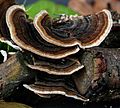Trametes versicolor facts for kids
|
||||||||||||||||||||||||||||||||
Trametes versicolor is a very common type of polypore mushroom found all over the world. Its name, versicolor, means 'of several colors'. This perfectly describes the fungus, which shows many different shades. Because it looks a bit like a wild turkey's tail with its shape and colors, T. versicolor is often called the turkey tail mushroom.
Sometimes, people might confuse it with other mushrooms that look similar. One is called the false turkey tail, and another is the multicolor gill polypore. Even though they look alike, these are different types of fungi.
Contents
What Does the Turkey Tail Mushroom Look Like?
The top part of the mushroom, called the cap, has rings of different colors. The edge of the cap is usually the lightest color. Underneath the top layer, there's a black part, and then the whitish flesh. This flesh is about 1 to 3 millimeters thick and feels a bit like leather.
Older turkey tail mushrooms might even have green areas because tiny green algae can grow on them. These mushrooms often grow in layers, like tiles on a roof. You can find them in groups or rows on fallen logs and tree stumps, especially from trees that lose their leaves. They are very common in places like North America.
The mushroom does not have a stalk. Its cap is usually rust-brown or a darker brown, sometimes with black rings. The cap is flat and can be up to 8 centimeters wide and 5 centimeters deep, and about 0.5 to 1 centimeter thick. It often looks like a triangle or a circle and has fine hairs. The underside of the cap has tiny holes, called pores, which are usually whitish to light brown. As the mushroom gets older, these pores can become twisted. There are about 3 to 8 pores in every millimeter.
Where Does the Turkey Tail Mushroom Grow?
T. versicolor is a type of white-rot fungus. This means it helps break down wood and other plant materials. It plays an important role in nature by recycling nutrients from dead trees.
Some small creatures like to eat this mushroom. These include caterpillars of the fungus moth Nemaxera betulinella, maggots from a fly called Polyporivora picta, and a type of fungus gnat called Mycetophila luctuosa. However, this mushroom is not considered safe for humans to eat.
Other Mushrooms That Look Similar
There are several other mushrooms that can look a lot like the turkey tail. These include Trametes hirsuta, T. ochracea, T. suaveolens, Bjerkandera adusta, Cerrena unicolor, Lenzites betulina, and Stereum hirsutum. Other types of Stereum mushrooms are also similar, but they usually have a smooth underside. Some Trichaptum species can also look alike.
How Is Turkey Tail Mushroom Used?
People have studied Trametes versicolor for different uses, especially because it contains special substances called polysaccharides.
Polysaccharide-K (PSK) Extract
One important substance taken from T. versicolor is called Polysaccharide-K (PSK). In Japan, this extract is known as kawaratake (which means roof tile mushroom). It has been approved there for use alongside other treatments.
PSK has been studied to see if it can help people with certain health conditions. However, scientists are still working to fully understand how effective it is. In some countries, PSK is sold as a dietary supplement. It's important to know that using PSK might cause some mild side effects, like an upset stomach or changes in stool color.
Important Warnings About Supplements
In the United States, the Food and Drug Administration (FDA) has warned some companies. These companies were selling T. versicolor PSK supplements and claiming they could treat serious illnesses. The FDA stated that these products were not proven to be safe or effective for those uses.
Trametes versicolor has also been used in traditional Chinese medicine and other types of herbal medicine for a long time.
Gallery
See also
 In Spanish: Trametes versicolor para niños
In Spanish: Trametes versicolor para niños
- List of Trametes species
- Polysaccharide-K
- Polysaccharide peptide
- Medicinal fungi










